Introduction
In today’s world, where dietary preferences and restrictions are as diverse as the people who hold them, understanding what foods are gluten-free is crucial. For those with celiac disease or gluten sensitivity, avoiding gluten is not just a choice—it’s a necessity. Two popular grains often discussed in this context are quinoa and couscous. But are quinoa and couscous truly gluten-free? This article delves into the gluten content of quinoa and couscous, comparing their nutritional profiles, culinary uses, and potential health benefits. We’ll also explore personal experiences and answer some frequently asked questions to provide a comprehensive guide on this topic.
Introduction to Quinoa and Couscous

Quinoa and couscous—two grains that have found their way into kitchens worldwide—are often mistaken for each other, yet they couldn’t be more different. Quinoa, a seed from the Andean region, has gained fame as a gluten-free grain packed with nutrients. Couscous, on the other hand, is a type of pasta made from wheat, traditionally enjoyed in North African cuisine. Understanding the differences between these two can help you make informed dietary choices.
Brief Overview of Quinoa and Couscous
Quinoa is often hailed as a superfood, and for good reason. It’s rich in protein, fiber, and essential amino acids, making it a staple for those seeking a nutritious, gluten-free option. Couscous, while similar in appearance, is made from semolina wheat, which means it contains gluten. This distinction is vital for anyone with gluten intolerance.
Importance of Understanding Gluten Content
Why does gluten content matter so much? For individuals with celiac disease, consuming gluten can lead to severe health issues, including digestive problems and nutrient malabsorption. Even those with non-celiac gluten sensitivity can experience discomfort. Therefore, knowing which foods are safe to eat is essential for maintaining health and well-being.
In the following sections, we’ll dive deeper into what gluten is, explore whether quinoa and couscous are gluten-free, and provide practical tips for incorporating these grains into a gluten-free diet.
Understanding Gluten
To truly grasp the significance of whether quinoa and couscous are gluten-free, it’s essential to understand what gluten is and why it matters. Gluten is a protein found in wheat, barley, and rye, and it gives dough its elasticity and chewy texture. However, for some people, gluten can be a real troublemaker.
What is Gluten?
Gluten is a composite of storage proteins, namely gliadin and glutenin, found in wheat and related grains. It’s what makes bread rise and gives it that delightful chewiness. But, for those with celiac disease, gluten is the enemy. When ingested, it triggers an immune response that damages the small intestine, leading to a host of health issues. Even those without celiac disease might experience gluten sensitivity, which can cause bloating, fatigue, and other uncomfortable symptoms.
Why Gluten Matters
So, why all the fuss about gluten? For individuals with celiac disease, consuming even a tiny amount of gluten can lead to severe health complications. The immune response damages the lining of the small intestine, which can result in nutrient deficiencies, anemia, and increased risk of other autoimmune disorders. For those with gluten sensitivity, while the effects aren’t as severe, they can still be quite unpleasant, leading to digestive discomfort and other symptoms.
Understanding gluten and its effects is crucial for anyone navigating a gluten-free diet. It helps in making informed choices about what to eat and what to avoid. In the next sections, we’ll explore whether quinoa and couscous fit into a gluten-free lifestyle and how to enjoy them safely.
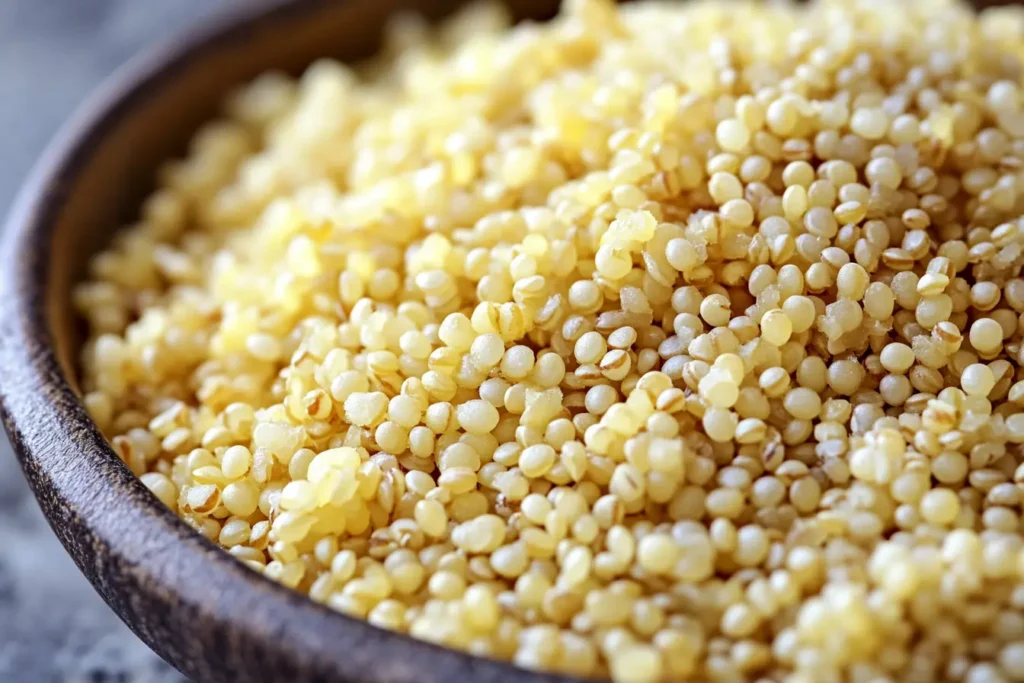
Is Quinoa Gluten-Free?
Quinoa has become a darling of the health food world, often touted as a gluten-free grain that’s packed with nutrients. But is it truly free of gluten, and what should you know before adding it to your diet?
Quinoa: A Gluten-Free Grain?
Yes, quinoa is naturally gluten-free. It’s not actually a grain but a seed from the Chenopodium plant, which is related to spinach and beets. This distinction is crucial because it means quinoa doesn’t contain the gluten proteins found in wheat, barley, or rye. For those with celiac disease or gluten sensitivity, quinoa offers a safe and nutritious alternative to traditional grains.
Nutritionally, quinoa is a powerhouse. It’s rich in protein, containing all nine essential amino acids, which is rare for plant-based foods. It’s also high in fiber, magnesium, B vitamins, iron, potassium, calcium, phosphorus, vitamin E, and various beneficial antioxidants. This makes quinoa not only a great gluten-free option but also a highly nutritious one.
Potential Contamination Risks
However, there’s a catch. While quinoa itself is gluten-free, cross-contamination can occur during processing and packaging. Facilities that process both gluten-containing grains and quinoa might inadvertently introduce gluten into the quinoa. To avoid this, it’s important to look for quinoa that is labeled as “certified gluten-free.” This certification ensures that the quinoa has been processed in a facility that minimizes the risk of cross-contamination.
Incorporating quinoa into your diet can be a delicious and healthy choice, but it’s essential to be mindful of potential contamination risks. In the next section, we’ll turn our attention to couscous and explore whether it can be part of a gluten-free diet.
Is Couscous Gluten-Free?
Couscous, with its tiny, grain-like appearance, often finds itself in the company of grains like quinoa. However, when it comes to gluten content, couscous tells a different story. Let’s unravel the gluten mystery surrounding couscous.
Couscous: A Gluten-Containing Pasta
Contrary to popular belief, couscous is not a grain but a type of pasta. It’s traditionally made from semolina, which is a coarse flour derived from durum wheat. This means that couscous naturally contains gluten, making it unsuitable for those with celiac disease or gluten sensitivity. While it might look similar to quinoa, couscous is firmly in the gluten-containing camp.
There are different types of couscous, such as Moroccan, Israeli (also known as pearl couscous), and Lebanese, but they all share the common ingredient of wheat. Therefore, if you’re following a gluten-free diet, traditional couscous is off the menu.
Gluten-Free Couscous Alternatives
But don’t despair! There are gluten-free alternatives to traditional couscous that can be enjoyed without worry. Some brands offer gluten-free couscous made from corn, rice, or even quinoa. These alternatives provide a similar texture and culinary versatility without the gluten.
When shopping for gluten-free couscous, it’s important to check the packaging for a “gluten-free” label to ensure that it meets the necessary standards. This way, you can enjoy dishes like tabbouleh or couscous salad without compromising your dietary needs.
In the next section, we’ll compare quinoa and couscous in terms of nutrition and culinary uses, helping you decide which might be the better fit for your gluten-free lifestyle.
Comparing Quinoa and Couscous
Now that we’ve explored the gluten content of quinoa and couscous, let’s dive into how these two popular foods stack up against each other in terms of nutrition and culinary versatility. Understanding these differences can help you make informed choices about which to include in your diet.
Nutritional Comparison
When it comes to nutrition, quinoa and couscous offer distinct profiles. Quinoa is often celebrated for its high protein content, boasting all nine essential amino acids, which makes it a complete protein source. This is particularly beneficial for vegetarians and vegans looking to meet their protein needs. Additionally, quinoa is rich in fiber, which aids digestion and helps maintain a feeling of fullness.
Couscous, being a wheat-based product, is lower in protein compared to quinoa. It does, however, provide a good source of selenium, an essential mineral that plays a role in metabolism and immune function. But, for those seeking a gluten-free diet, the nutritional benefits of couscous are overshadowed by its gluten content.
Culinary Uses and Versatility
In the kitchen, both quinoa and couscous shine in their own ways. Quinoa’s nutty flavor and fluffy texture make it a versatile ingredient in salads, soups, and as a side dish. It can be used as a base for grain bowls or even as a substitute for rice in many recipes. Its ability to absorb flavors makes it a favorite in various cuisines.
Couscous, with its quick cooking time and mild taste, is a staple in North African and Middle Eastern dishes. It’s often used in salads, stews, and as a side dish. However, for those avoiding gluten, exploring gluten-free couscous alternatives can open up similar culinary possibilities without the gluten risk.
Incorporating these foods into your diet can add variety and nutrition, but it’s important to choose the right one based on your dietary needs. In the next section, I’ll share my personal experience with quinoa and couscous, offering insights and tips for enjoying them in a gluten-free lifestyle.
Cooking Tips and Recipes
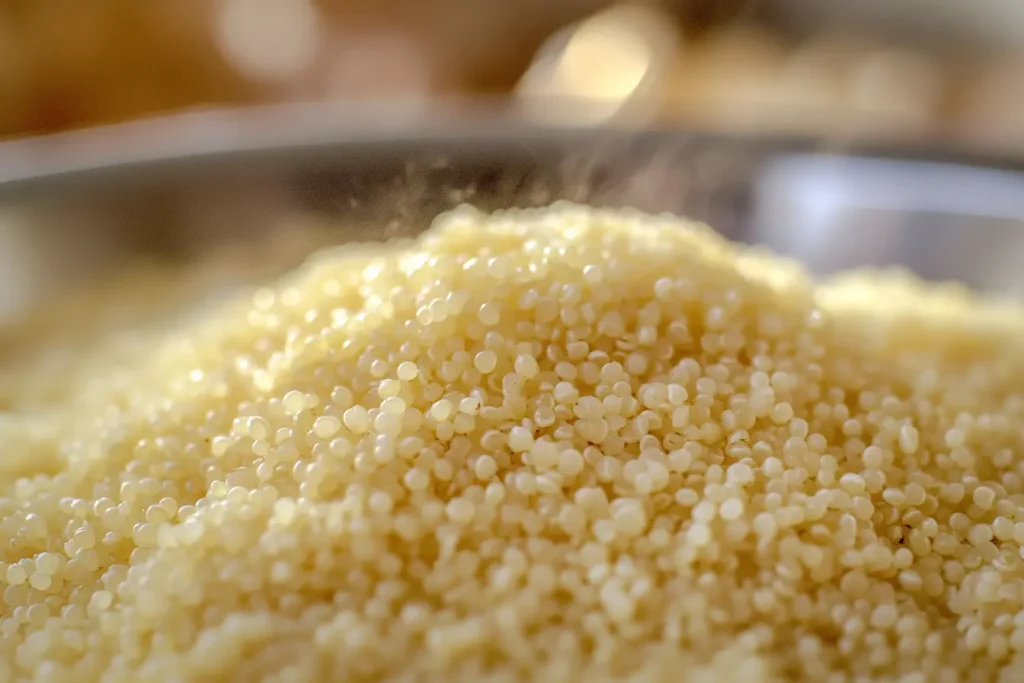
Cooking with quinoa and gluten-free couscous can be a delightful culinary adventure. Here are some tips and recipes to help you make the most of these versatile ingredients.
Cooking with Quinoa
Tips for Perfect Quinoa Every Time
Cooking quinoa is straightforward, but a few tricks can elevate your dish. First, always rinse quinoa thoroughly under cold water to remove its natural coating, saponin, which can taste bitter. Use a 2:1 water-to-quinoa ratio, bringing it to a boil before simmering for about 15 minutes. Let it sit covered for a few minutes after cooking to absorb any remaining moisture, then fluff with a fork.
Simple and Delicious Quinoa Recipes
- Quinoa Salad with Avocado and Black Beans: Combine cooked quinoa with diced avocado, black beans, cherry tomatoes, and a lime vinaigrette for a refreshing salad.
- Quinoa Breakfast Bowl: Mix quinoa with almond milk, a dash of cinnamon, and top with fresh berries and nuts for a nutritious start to your day.
Cooking with Gluten-Free Couscous
How to Prepare Gluten-Free Couscous
Gluten-free couscous is just as easy to prepare as the traditional kind. Follow the package instructions, typically involving boiling water, adding the couscous, and letting it sit covered for a few minutes. Fluff with a fork before serving.
Tasty Recipes Using Gluten-Free Couscous
- Mediterranean Couscous Salad: Toss gluten-free couscous with cucumbers, olives, feta cheese, and a drizzle of olive oil for a Mediterranean-inspired dish.
- Couscous and Vegetable Stir-Fry: Sauté your favorite vegetables and mix them with prepared couscous for a quick and healthy meal.
Health Benefits Beyond Gluten-Free
While quinoa and couscous are often discussed in the context of gluten, they offer a range of other health benefits worth exploring.
Nutritional Advantages of Quinoa
Antioxidants and Their Benefits
Quinoa is rich in antioxidants, which help combat oxidative stress and reduce inflammation. These compounds can support overall health and may lower the risk of chronic diseases.
Impact on Heart Health and Metabolism
The high fiber content in quinoa can aid in lowering cholesterol levels, promoting heart health. Additionally, its protein and nutrient density can boost metabolism and support weight management.
Couscous and Its Nutritional Role
Vitamins and Minerals in Couscous
Couscous provides essential nutrients like selenium, which supports immune function and thyroid health. It’s also a good source of B vitamins, which are crucial for energy production.
How Couscous Fits into a Balanced Diet
While couscous contains gluten, its nutritional profile can complement a balanced diet when consumed in moderation. Pairing it with vegetables and lean proteins can create a well-rounded meal.
Exploring Other Gluten-Free Grains
For those seeking variety in their gluten-free diet, there are several other grains to consider.
Alternative Gluten-Free Grains
Millet, Amaranth, and Buckwheat
These grains are naturally gluten-free and offer unique flavors and textures. Millet is mild and fluffy, amaranth is nutty and slightly crunchy, and buckwheat has a robust, earthy taste.
How to Incorporate These Grains into Your Diet
- Millet Porridge: Cook millet with milk and sweeten with honey for a comforting breakfast.
- Amaranth Stir-Fry: Use amaranth as a base for a vegetable stir-fry, adding a nutty flavor to the dish.
- Buckwheat Pancakes: Make gluten-free pancakes using buckwheat flour for a hearty breakfast option.
Comparing Nutritional Profiles
How These Grains Stack Up Against Quinoa and Couscous
Each of these grains offers distinct nutritional benefits. For example, amaranth is high in protein and calcium, while buckwheat is rich in fiber and magnesium. Exploring these options can diversify your diet and provide a range of nutrients.
Benefits of Diversifying Your Grain Intake
Incorporating a variety of gluten-free grains can enhance your diet’s nutritional value and keep meals interesting. By experimenting with different grains, you can discover new flavors and textures that complement your dietary needs.
Personal Experience
When it comes to navigating a gluten-free lifestyle, personal experiences can offer valuable insights and practical tips. Having explored both quinoa and couscous in my own kitchen, I’ve discovered some delightful ways to incorporate these foods into a gluten-free diet.
My Experience with Quinoa and Couscous
Quinoa quickly became a staple in my pantry once I embraced a gluten-free lifestyle. Its versatility is unmatched; I love using it as a base for salads, mixing it with fresh vegetables, herbs, and a zesty dressing for a refreshing meal. One of my favorite combinations is quinoa with cherry tomatoes, cucumber, feta cheese, and a splash of lemon juice. It’s not only delicious but also packed with nutrients.
On the other hand, couscous was a bit of a challenge initially due to its gluten content. However, discovering gluten-free couscous alternatives made from corn or rice was a game-changer. These alternatives have allowed me to enjoy traditional dishes like couscous salad and Moroccan tagine without worrying about gluten. The texture is slightly different, but the taste and satisfaction remain.
Tips for Incorporating Them into a Gluten-Free Diet
For those new to quinoa, I recommend rinsing it thoroughly before cooking to remove its natural coating, called saponin, which can taste bitter. Cooking quinoa in vegetable or chicken broth instead of water can also enhance its flavor.
When it comes to gluten-free couscous, be sure to follow the cooking instructions on the package, as the cooking time and method can vary depending on the base ingredient. Experimenting with different spices and herbs can also elevate the dish and make it more exciting.
Incorporating these foods into your diet can be both enjoyable and beneficial. In the next section, we’ll address some frequently asked questions about quinoa and couscous, providing further clarity on their gluten content and health benefits.
Environmental Impact and Sustainability
As we become more conscious of our food choices, understanding the environmental impact of quinoa and couscous production is essential.
Quinoa’s Environmental Footprint
Sustainability of Quinoa Farming
Quinoa is primarily grown in the Andean regions of South America, where it has been cultivated for thousands of years. Its ability to thrive in harsh conditions makes it a resilient crop. However, the global demand for quinoa has led to increased farming, which can strain local resources and affect traditional farming practices.
Efforts to Promote Sustainable Practices
To address these challenges, initiatives are underway to promote sustainable quinoa farming. These include fair trade practices, organic farming, and supporting local farmers to ensure that quinoa production remains environmentally friendly and beneficial to local communities.
Couscous and Wheat Production
Environmental Considerations of Wheat Farming
Wheat, the primary ingredient in couscous, is a staple crop worldwide. However, wheat farming can have significant environmental impacts, including soil degradation and water usage. Sustainable farming practices, such as crop rotation and reduced pesticide use, are essential to mitigate these effects.
Exploring Sustainable Alternatives
Choosing gluten-free couscous made from alternative grains like corn or rice can reduce reliance on wheat and support more sustainable agricultural practices. These alternatives often require fewer resources and can be grown in diverse climates.
Cultural Significance and History
Understanding the cultural roots of quinoa and couscous can enrich our appreciation of these foods.
The Cultural Heritage of Quinoa
Quinoa’s Role in Andean Culture
Quinoa has been a staple in the Andean diet for centuries, revered as a sacred crop by the Incas. It played a crucial role in their agriculture and nutrition, providing sustenance in the high-altitude regions where other crops struggled to grow.
Modern-Day Revival and Global Popularity
In recent years, quinoa has gained international popularity, celebrated for its nutritional benefits and versatility. This global demand has brought economic opportunities to Andean farmers, though it also poses challenges in balancing traditional practices with modern demands.
Couscous in North African Cuisine
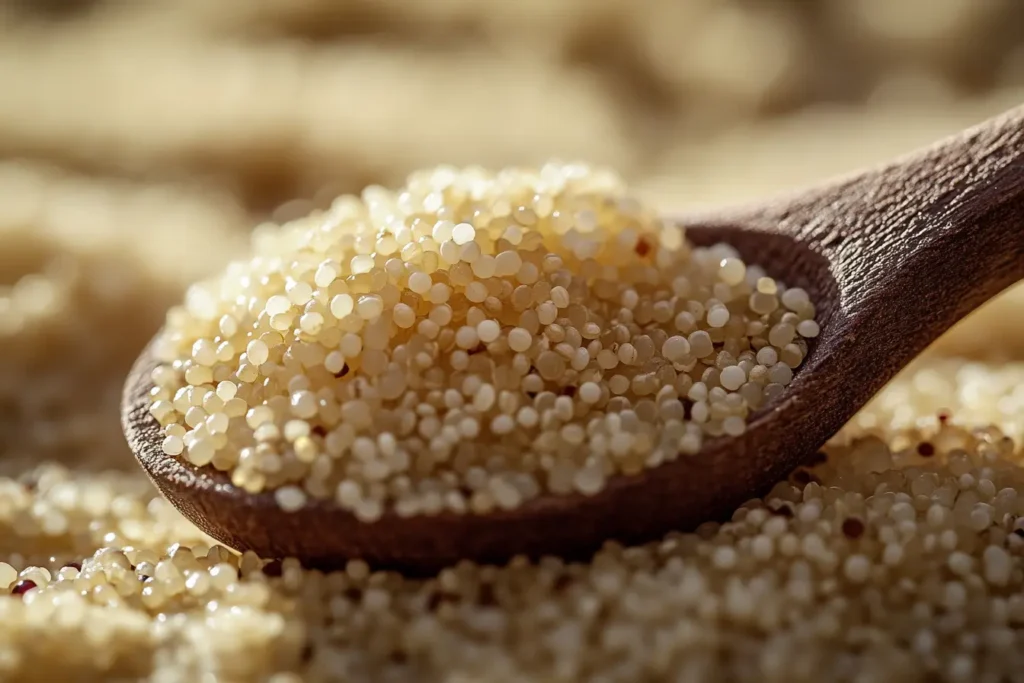
Traditional Uses and Celebrations
Couscous is a central element in North African cuisine, often served during family gatherings and celebrations. It’s traditionally steamed and served with meat, vegetables, and aromatic spices, reflecting the rich culinary heritage of the region.
Couscous in Contemporary Cooking
Today, couscous is enjoyed worldwide, adapted into various cuisines and recipes. Its ease of preparation and ability to absorb flavors make it a favorite in modern kitchens, bridging cultural traditions with contemporary tastes.
Addressing Common Misconceptions
Clearing up misconceptions about quinoa and couscous can help consumers make informed choices.
Misconception: Quinoa is a Grain
Clarifying Quinoa’s Botanical Classification
While often referred to as a grain, quinoa is actually a seed from the Chenopodium plant. This distinction is important for understanding its nutritional profile and gluten-free status.
Implications for Gluten-Free Diets
Recognizing quinoa as a seed helps clarify why it’s naturally gluten-free and suitable for those with gluten intolerance.
Misconception: All Couscous is the Same
Understanding Different Types of Couscous
Not all couscous is created equal. Traditional couscous is made from wheat, but gluten-free versions are available, made from alternative grains. Understanding these differences is crucial for those following a gluten-free diet.
Choosing the Right Couscous for Your Needs
By exploring the variety of couscous options, consumers can select the best fit for their dietary preferences and health goals, ensuring they enjoy this versatile food without compromising their needs.
Economic Impact and Market Trends
Exploring the economic aspects of quinoa and couscous can provide insight into their global significance and market dynamics.
The Quinoa Boom
Economic Opportunities for Andean Farmers
The rising global demand for quinoa has created significant economic opportunities for farmers in the Andean regions. This “quinoa boom” has led to increased income and improved living standards for many local communities. However, it also presents challenges, such as maintaining sustainable farming practices and ensuring fair trade.
Market Trends and Consumer Preferences
Quinoa’s popularity continues to grow, driven by its health benefits and versatility. As consumers become more health-conscious, the demand for organic and sustainably sourced quinoa is on the rise. This trend encourages producers to adopt environmentally friendly practices and cater to a global market that values quality and sustainability.
Couscous in the Global Market
Export and Consumption Patterns
Couscous is a staple in North African cuisine, but its appeal has spread worldwide. Countries like Morocco and Tunisia are major exporters, supplying couscous to international markets. The ease of preparation and adaptability of couscous make it a popular choice in diverse culinary traditions.
Innovations and Product Development
The market for couscous is evolving, with innovations such as flavored and instant couscous catering to modern consumers’ needs. Additionally, the development of gluten-free couscous options has expanded its reach, allowing those with dietary restrictions to enjoy this versatile food.
Future Prospects and Innovations
Looking ahead, the future of quinoa and couscous is shaped by innovation and evolving consumer demands.
Innovations in Quinoa Cultivation
Breeding and Genetic Research
Research into quinoa’s genetic diversity is paving the way for new varieties that can thrive in different climates and resist pests. These innovations aim to increase yield and ensure a stable supply, meeting the growing global demand while preserving biodiversity.
Sustainable Farming Practices
As sustainability becomes a priority, efforts to promote organic farming and reduce environmental impact are gaining momentum. These practices not only benefit the environment but also enhance the quality and appeal of quinoa in the market.
The Future of Couscous
Expanding Gluten-Free Options
The development of gluten-free couscous alternatives is set to continue, with new ingredients and formulations offering more choices for consumers. This expansion caters to the increasing number of people seeking gluten-free diets and opens up new culinary possibilities.
Culinary Innovations and Trends
Couscous is likely to remain a favorite in kitchens worldwide, with chefs and home cooks experimenting with new flavors and combinations. As global cuisines continue to influence each other, couscous will adapt and evolve, maintaining its place as a versatile and beloved food.
These additional sections provide a comprehensive view of quinoa and couscous, covering their economic impact, market trends, and future prospects. By exploring these topics, readers can gain a deeper understanding of the significance and potential of these foods in a global context.
Dietary Considerations and Allergies
Understanding how quinoa and couscous fit into various dietary needs and potential allergy concerns is crucial for making informed food choices.
Quinoa and Dietary Needs
For Special Diets
Quinoa is a versatile ingredient that fits well into many dietary plans. It’s a staple for vegetarians and vegans due to its complete protein profile. Additionally, its high fiber content makes it suitable for those following a heart-healthy or weight management diet. Quinoa is also a great option for those with diabetes, as it has a low glycemic index, helping to maintain stable blood sugar levels.
Potential Allergies and Sensitivities
While quinoa is generally well-tolerated, some individuals may experience digestive discomfort due to its saponin coating. Thoroughly rinsing quinoa before cooking can help reduce this risk. It’s always advisable to introduce new foods gradually and monitor for any adverse reactions.
Couscous and Dietary Restrictions
Couscous in a Balanced Diet
Traditional couscous, made from wheat, is not suitable for those with gluten intolerance. However, it can be part of a balanced diet for those without such restrictions, providing a source of carbohydrates and essential nutrients like selenium and B vitamins.
Addressing Gluten Sensitivity
For those with gluten sensitivity or celiac disease, gluten-free couscous alternatives offer a safe and delicious option. These alternatives allow individuals to enjoy the texture and versatility of couscous without the gluten-related concerns.
Community and Cultural Impact
Exploring the community and cultural significance of quinoa and couscous highlights their roles beyond nutrition.
Quinoa’s Role in Andean Communities
Cultural Heritage and Identity
Quinoa is deeply embedded in the cultural heritage of Andean communities. It has been a staple food for centuries, playing a vital role in traditional ceremonies and daily life. The resurgence of quinoa’s popularity has helped preserve cultural practices and promote pride in indigenous agricultural knowledge.
Community Development and Empowerment
The global demand for quinoa has brought economic benefits to Andean farmers, fostering community development and empowerment. Initiatives that support fair trade and sustainable farming practices ensure that these communities can thrive while maintaining their cultural identity.
Couscous in North African Society
Symbol of Hospitality and Tradition
In North African cultures, couscous is more than just a food—it’s a symbol of hospitality and tradition. It is often served during family gatherings and celebrations, reflecting the region’s rich culinary heritage and social customs.
Cultural Exchange and Global Influence
As couscous has gained international popularity, it has become a vehicle for cultural exchange, introducing North African flavors and traditions to a global audience. This exchange enriches culinary diversity and fosters appreciation for the cultural roots of this beloved dish.
These sections delve into the broader implications of quinoa and couscous, emphasizing their roles in dietary considerations and cultural contexts. By understanding these aspects, readers can appreciate the significance of these foods beyond their nutritional value.
FAQs
Navigating the world of gluten-free foods can be tricky, and it’s natural to have questions about quinoa and couscous. Here, we’ll address some of the most common queries to help you make informed dietary choices.
Frequently Asked Questions
Is quinoa always gluten-free?
Yes, quinoa is naturally gluten-free, making it a safe choice for those with celiac disease or gluten sensitivity. However, it’s crucial to be aware of potential cross-contamination during processing. To ensure you’re getting a truly gluten-free product, look for quinoa that is labeled as “certified gluten-free.”
Can couscous be made gluten-free?
Traditional couscous is made from wheat and contains gluten. However, there are gluten-free alternatives available, made from ingredients like corn, rice, or even quinoa. These options provide a similar texture and can be used in the same way as regular couscous, allowing you to enjoy your favorite dishes without the gluten.
What are the health benefits of quinoa over couscous?
Quinoa offers several nutritional advantages over couscous, particularly for those seeking a gluten-free diet. It’s a complete protein, containing all nine essential amino acids, and is rich in fiber, vitamins, and minerals. Quinoa’s high protein and fiber content can help with satiety and digestion, making it a more nutrient-dense option compared to traditional couscous.
How to avoid cross-contamination with quinoa?
To minimize the risk of cross-contamination, purchase quinoa that is labeled as “certified gluten-free.” This certification indicates that the quinoa has been processed in a facility that takes precautions to prevent gluten contamination. Additionally, store quinoa separately from gluten-containing foods in your kitchen to avoid accidental mixing.
By addressing these common questions, we hope to provide clarity and confidence in choosing the right foods for a gluten-free lifestyle. In the final section, we’ll wrap up our exploration of quinoa and couscous, summarizing the key points and encouraging further exploration of gluten-free options.
Conclusion
As we wrap up our exploration of quinoa and couscous, it’s clear that understanding the gluten content of these foods is essential for anyone following a gluten-free diet. Quinoa, with its impressive nutritional profile and natural gluten-free status, stands out as a versatile and healthful option. Whether you’re looking to boost your protein intake or simply enjoy a delicious meal, quinoa fits the bill.
Couscous, while traditionally made from wheat and containing gluten, doesn’t have to be off-limits. Thanks to gluten-free alternatives, you can still enjoy the texture and taste of couscous without compromising your dietary needs. By choosing products labeled as “gluten-free” and being mindful of cross-contamination, you can safely incorporate these foods into your meals.
Ultimately, both quinoa and couscous offer unique benefits and can be enjoyed in a variety of dishes. Whether you’re preparing a hearty salad, a comforting stew, or a simple side dish, these ingredients can add flavor and nutrition to your gluten-free lifestyle. So, go ahead and experiment in the kitchen, knowing that you have the knowledge to make informed and delicious choices.
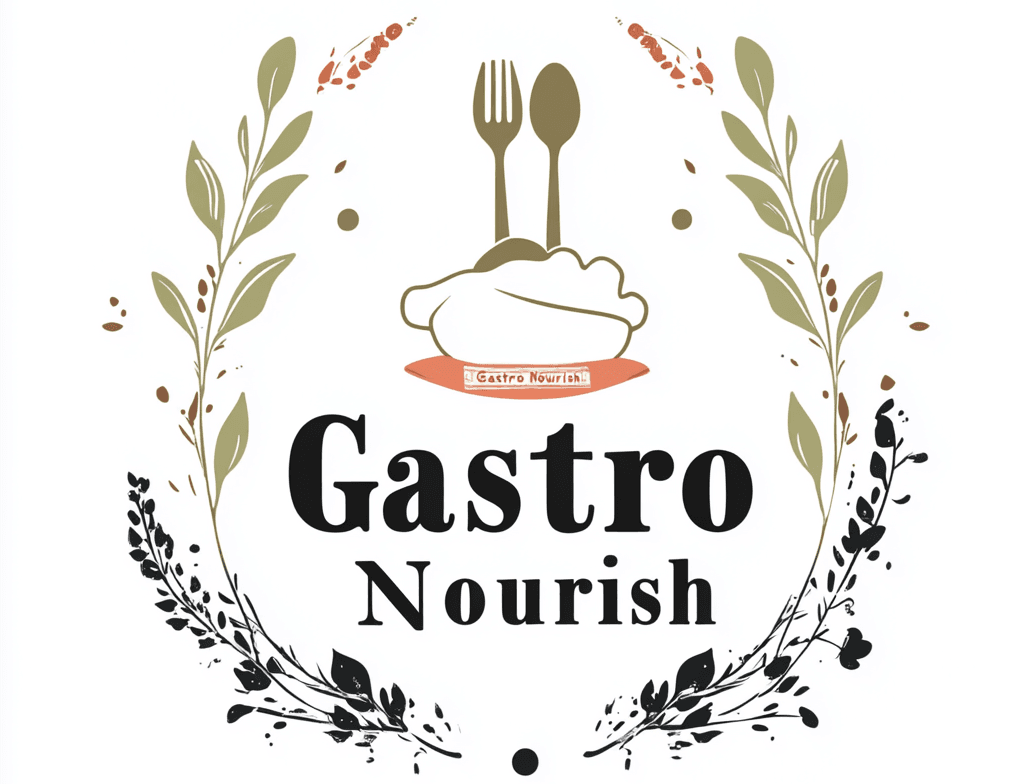
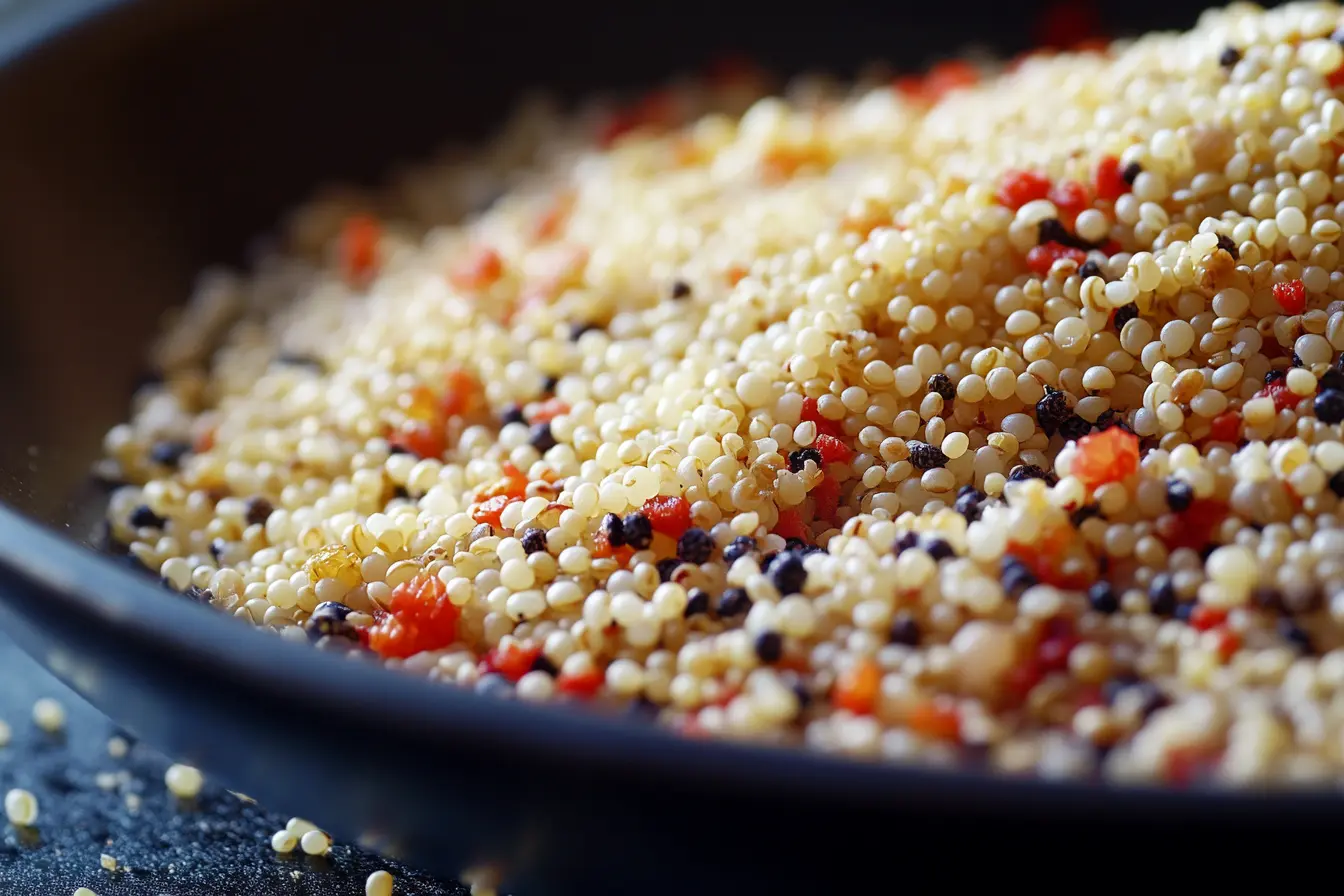
2 thoughts on “Is Quinoa and Couscous Gluten-Free? A Comprehensive Guide”